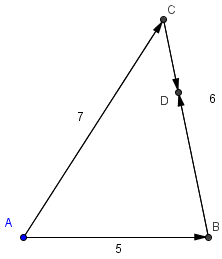Difference between revisions of "2007 AMC 12B Problems/Problem 6"
m (img etc) |
|||
| Line 3: | Line 3: | ||
Triangle <math>ABC</math> has side lengths <math>AB = 5</math>, <math>BC = 6</math>, and <math>AC = 7</math>. Two bugs start simultaneously from <math>A</math> and crawl along the sides of the triangle in opposite directions at the same speed. They meet at point <math>D</math>. What is <math>BD</math>? | Triangle <math>ABC</math> has side lengths <math>AB = 5</math>, <math>BC = 6</math>, and <math>AC = 7</math>. Two bugs start simultaneously from <math>A</math> and crawl along the sides of the triangle in opposite directions at the same speed. They meet at point <math>D</math>. What is <math>BD</math>? | ||
| − | <math>\mathrm {(A)} 1 | + | <math>\mathrm {(A)}\ 1 \qquad \mathrm {(B)}\ 2 \qquad \mathrm {(C)}\ 3 \qquad \mathrm {(D)}\ 4 \qquad \mathrm {(E)}\ 5</math> |
==Solution== | ==Solution== | ||
| − | + | [[Image:2007_12B_AMC-6.png]] | |
| − | |||
One bug goes to <math>B</math>. The path that he takes is <math>\dfrac{5+6+7}{2}=9</math> units long. The length of <math>BD</math> is <math>9-AB=9-5=4 \Rightarrow \mathrm {(D)}</math> | One bug goes to <math>B</math>. The path that he takes is <math>\dfrac{5+6+7}{2}=9</math> units long. The length of <math>BD</math> is <math>9-AB=9-5=4 \Rightarrow \mathrm {(D)}</math> | ||
| − | ==See | + | ==See also== |
| + | {{AMC12 box|year=2007|ab=B|num-b=5|num-a=7}} | ||
| − | + | [[Category:Introductory Geometry Problems]] | |
Revision as of 16:51, 17 October 2007
Problem
Triangle ![]() has side lengths
has side lengths ![]() ,
, ![]() , and
, and ![]() . Two bugs start simultaneously from
. Two bugs start simultaneously from ![]() and crawl along the sides of the triangle in opposite directions at the same speed. They meet at point
and crawl along the sides of the triangle in opposite directions at the same speed. They meet at point ![]() . What is
. What is ![]() ?
?
![]()
Solution
One bug goes to ![]() . The path that he takes is
. The path that he takes is ![]() units long. The length of
units long. The length of ![]() is
is ![]()
See also
| 2007 AMC 12B (Problems • Answer Key • Resources) | |
| Preceded by Problem 5 |
Followed by Problem 7 |
| 1 • 2 • 3 • 4 • 5 • 6 • 7 • 8 • 9 • 10 • 11 • 12 • 13 • 14 • 15 • 16 • 17 • 18 • 19 • 20 • 21 • 22 • 23 • 24 • 25 | |
| All AMC 12 Problems and Solutions | |










